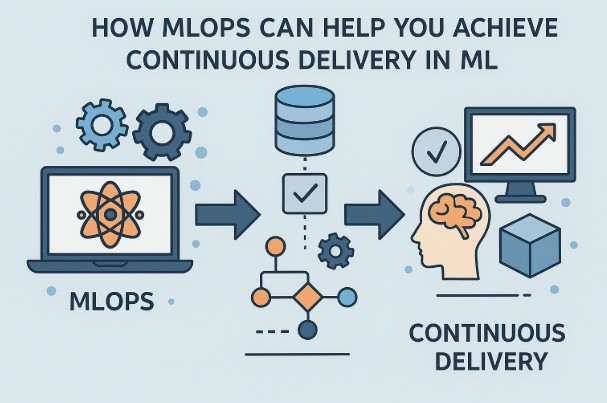Table of Contents
Introduction
In the rapidly evolving world of machine learning (ML), the ability to continuously deliver high-quality models is crucial for staying competitive. MLOps, a combination of machine learning and DevOps practices, provides a framework for automating and streamlining the deployment, monitoring, and management of ML models. This article explores how MLOps can help you achieve continuous delivery in ML, from basic concepts to advanced strategies.
What is MLOps?
MLOps, short for Machine Learning Operations, is the practice of collaboration and communication between data scientists and operations professionals to manage the lifecycle of machine learning models. It integrates DevOps principles with ML systems to automate the process of deploying and maintaining models in production.
Key Components of MLOps
- Version Control: Keeping track of changes to code and models.
- CI/CD Pipelines: Automating the build, test, and deployment process.
- Monitoring: Continuously tracking model performance and data drift.
- Automation: Reducing manual intervention through automated workflows.
Why is Continuous Delivery Important in ML?
Continuous delivery (CD) ensures that software and ML models can be reliably released at any time. It allows organizations to respond quickly to changing market demands, improves collaboration between teams, and ensures higher-quality products.
Benefits of Continuous Delivery in ML
- Faster Time to Market: Rapid iteration and deployment of models.
- Improved Collaboration: Better communication between data scientists, engineers, and stakeholders.
- Higher Quality: Early detection of issues through automated testing.
- Scalability: Easier to manage and scale ML workflows.
Implementing MLOps for Continuous Delivery
Step 1: Establish a Version Control System
A robust version control system (VCS) is essential for managing changes to code and models. Git is a popular choice for its widespread use and integration capabilities.
Best Practices for Version Control in ML
- Branching Strategies: Use feature branches to develop new models.
- Commit Frequency: Commit changes frequently to avoid large, complex merges.
- Tagging Releases: Use tags to mark specific releases for easier rollback if needed.
Step 2: Set Up CI/CD Pipelines
Continuous Integration (CI) and Continuous Deployment (CD) pipelines automate the process of building, testing, and deploying ML models.
Building CI/CD Pipelines
- Automated Testing: Integrate unit tests, integration tests, and model validation tests.
- Environment Management: Use containerization (e.g., Docker) to ensure consistency across environments.
- Orchestration Tools: Utilize tools like Jenkins, GitLab CI, or CircleCI for pipeline automation.
Step 3: Monitor Model Performance
Monitoring is critical to ensure that models perform as expected and adapt to changing data patterns.
Techniques for Monitoring
- Performance Metrics: Track metrics such as accuracy, precision, recall, and F1 score.
- Data Drift Detection: Identify shifts in data distribution that may impact model performance.
- Alerting Systems: Set up alerts for significant deviations in performance.
Step 4: Automate Workflows
Automation reduces the need for manual intervention, ensuring faster and more reliable deployment processes.
Automation Strategies
- Hyperparameter Tuning: Use automated tools like Optuna or Hyperopt to optimize model parameters.
- Model Retraining: Set up automated retraining schedules based on new data availability.
- Deployment Automation: Utilize tools like Kubernetes for scalable and automated model deployment.
Advanced Strategies for MLOps
A/B Testing for Model Validation
A/B testing allows you to compare different versions of models to determine which performs better in production.
Implementing A/B Testing
- Traffic Splitting: Divide traffic between multiple model versions.
- Statistical Analysis: Use statistical methods to compare performance metrics.
- Feedback Loops: Incorporate user feedback into model improvement.
Feature Store for Reusable Features
A feature store is a centralized repository for storing and sharing ML features across projects.
Benefits of a Feature Store
- Consistency: Ensure consistent feature definitions across models.
- Reusability: Reuse features to save time and reduce redundancy.
- Collaboration: Enhance collaboration between data scientists through shared resources.
Model Explainability and Interpretability
Understanding how models make decisions is crucial for building trust and ensuring compliance with regulations.
Tools for Explainability
- LIME (Local Interpretable Model-agnostic Explanations): Provides local explanations for individual predictions.
- SHAP (SHapley Additive exPlanations): Offers a unified approach to explain model outputs.
MLOps in the Cloud
Cloud platforms like AWS, Azure, and Google Cloud provide robust tools and services for implementing MLOps.
Cloud Services for MLOps
- AWS SageMaker: Comprehensive suite for building, training, and deploying ML models.
- Azure Machine Learning: Platform for managing the entire ML lifecycle.
- Google AI Platform: Integrated services for ML development and deployment.
FAQs
What is MLOps?
MLOps is the practice of combining machine learning and DevOps principles to automate and streamline the deployment and management of ML models.
Why is continuous delivery important in ML?
Continuous delivery ensures that ML models can be reliably released at any time, allowing for faster iteration, improved collaboration, higher quality, and better scalability.
How can I implement MLOps in my organization?
Start by establishing a version control system, setting up CI/CD pipelines, monitoring model performance, and automating workflows. Utilize advanced strategies like A/B testing, feature stores, and cloud services for further optimization.
What tools are commonly used in MLOps?
Common tools include Git for version control, Jenkins for CI/CD pipelines, Docker for containerization, Kubernetes for deployment, and cloud services like AWS SageMaker, Azure Machine Learning, and Google AI Platform.

Conclusion
MLOps is a transformative practice that enables continuous delivery in ML, ensuring that models can be deployed and maintained efficiently. By implementing best practices and leveraging the right tools, organizations can achieve faster time to market, improved collaboration, higher quality models, and better scalability. Embrace MLOps to stay ahead in the competitive landscape of machine learning.Thank you for reading the DevopsRoles page!
